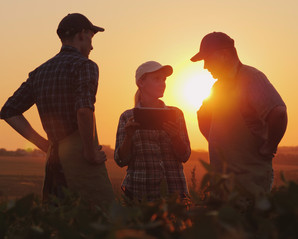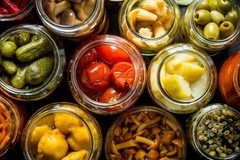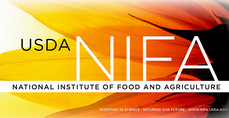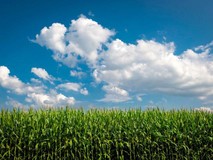|
Having trouble viewing this email? View it as a Web page.

|
|
|
Editor: Kelly Sprute September 8, 2021
Making a Difference

NIFA Celebrates Labor Day
Workers are crucial to our food system. From fields to processors to grocery stores and kitchens, the safety, well-being, and productivity of our workforce is foundational to our economy and food security both here and abroad. Indeed, across every industry, the United States workforce is the backbone of our great nation. The National Institute of Food and Agriculture (NIFA) understands the importance of workers up and down the food value chain, which is why we invest in programs that prioritize workers. We invite you to explore how NIFA works with public and private partners to build a promising future for agricultural workers and keep them safe. For more information, read this NIFA blog.
Farmers shaking hands in a field at sunset, courtesy of Adobe Stock.
|
|
|

Meet NIFA’s New Division Director of Animal Systems
Dr. Robert W. Godfrey joins the National Institute of Food and Agriculture as the new Division Director of Animal Systems in the Institute of Food Production and Sustainability.
Dr. Godfrey earned his B.S. in Animal Science and Industry at Kansas State University in 1980, and his M.S. and PhD in Reproductive Physiology at Texas A&M University in 1982 and 1987. He was a post-doctoral research affiliate at the USDA Agriculture Research Service Meat Animal Research Center in Clay Center, Nebraska from 1987 to 1989. In 1989 he moved to the Cincinnati Zoo as Rhinoceros Research Coordinator at the Center for Reproduction of Endangered Wildlife. In 1992, he returned to Texas A&M where he was a research associate in the Department of Veterinary Anatomy and Public Health, College of Veterinary Medicine. In 1993, Dr. Godfrey accepted a position as Assistant Professor (Research) of Animal Science at the Agricultural Experiment Station of the University of the Virgin Islands, St. Croix. There he conducted research with St. Croix White Hair sheep, beef, and dairy cattle, and worked his way up to Associate and Professor in 1998 and 2006. In 2000, Dr. Godfrey was appointed as Associate Director and then Director of the experiment station in 2011, while maintaining his research program activities.
Over the years his research has focused on reproductive physiology of sheep and cattle as well as the impact of the environment on livestock fertility, health, and production. He has conducted both applied and basic research in response to stakeholder needs. Dr. Godfrey has received numerous grants to support his research, develop student opportunities to participate in agricultural research and published manuscripts in a variety of formats (journals, proceedings, book chapters). His work with St. Croix White Hair sheep and Senepol cattle was recognized by the St. Croix Hair Sheep International Association and the Senepol Cattle Breeders Association
Dr. Godfrey is active in the American Society of Animal Science and the Experiment Station Section serving on various committees at the national and regional level. He has also served on various boards and committees within the Association of Public and Land Grant Universities, representing both the southern region and the Insular Land Grant Institutions. In 2020 he received the Excellence in Leadership Award for the Southern Association of Agricultural Experiment Station Directors.
He has made a concerted effort to be an active participant in the Land-Grant system at the local, regional, and national level. Dr. Godfrey has provided leadership to faculty, staff, and students in support of agriculture research to meet the needs of the local, national, and global agricultural community.
|

Investing in Non-Land Grant University Ag Research
Colleges and Universities with ag research and Extension programs not under the Land-grant University designation recently received federal grants to continue their innovation and teaching efforts. USDA’s Rod Bain talks with National Institute of Food and Agriculture Director Carrie Castille about how USDA invests in agricultural sciences and food security higher education. For more information, listen to this USDA broadcast.
Director, National Institute of Food and Agriculture Dr. Carrie Castille.
|

USDA's Complete Guide to Home Canning
As summer gardening season winds down, many of us are enjoying this year’s harvest and, for some, a surplus harvest. Don’t know what to do with all your tomatoes, cucumbers, peppers, apples, pears, plums and grapes from your garden and fruit trees? Have you considered preserving them? Everything you need to know about canning and food preservation is available in USDA’s Complete Guide to Home Canning. This resource is for people canning for the first time or for experienced canners wanting to improve their canning practices. The information is based on research conducted by the National Center for Home Food Preservation in cooperation with USDA’s National Institute of Food and Agriculture. For more information, read this NIFA blog.
Various foods in glass canning jars, courtesy of Adobe Stock.
|

A Legacy for a Sustainable Food System Legend
The nutrition incentive program honoring a former USDA Under Secretary recently awarded grants that expanded focus on systems impacted by the COVID-19 pandemic. USDA’s Rod Bain talks with the National Institute of Food and Agriculture (NIFA) Deputy Director of Food Safety and Nutrition. Dr. Suzanne Stluka discusses NIFA’s Gus Schumacher Nutrition Incentive Program and how it improves the accessibility and affordability of food systems. For more information, listen to this USDA broadcast.
NIFA Deputy Director of Food Safety and Nutrition Dr. Suzanne Stluka.
|

NIFA Career Opportunities
We are hiring! The National Institute of Food and Agriculture (NIFA) recruits a diverse group of talented, creative, motivated professionals who are invested in shaping the future of food and agricultural science. We offer a variety of benefits and services to our employees that focus on work-life balance, career enhancement, and health and well-being. NIFA has career opportunities in a variety of scientific disciplines covering engineering, food science, forestry, education, animal and crop sciences, and many other agriculture-related disciplines. NIFA job openings are listed on USAJobs. Current NIFA job openings are for Kansas City, Missouri, or location negotiable after selection.
Biological Science Specialist (National Program Leader) (GS 13-14)
Closing Date: September 13, or when we have received 150 applications.
View the public (all citizen) job announcement.
|

Pigskin and Peaches: Rivals Have Common Goal
Georgia and South Carolina share a border, a passion for football and pride in their peaches. Despite their football rivalry, University of Georgia (UGA) and Clemson University researchers have worked together for years to help peach producers overcome the challenges of growing peaches by planning defense strategies against diseases, pests, and climate variations. This season, peach entomologist Brett Blaauw is collaborating with Clemson plant pathologist Guido Schnabel and horticulturist Juan Carlos Melgar to investigate how various mulching techniques can affect soil health and the subsequent impacts on tree health and insect pests, and how using horticultural oil to manage San Jose scale can be incorporated into the current disease management program for peaches. This work is funded by USDA’s National Institute of Food and Agriculture. For more information, read this Clemson News article.
Clemson and UGA researchers combine forces to grow the perfect peach, courtesy of Clemson University.
|

NIFA Grant to Support Multidisciplinary Genome-to-Phenome Research
The Agricultural Genome to Phenome Initiative has awarded seven grants to institutions across the country for projects that help advance crop and livestock genetics research. "Projects such as this will help advance the field of genome-to-phenome research by identifying ways to share data and approaches across crops and livestock," says Patrick Schnable, AG2PI lead scientist and distinguished professor at Iowa State University. "We anticipate that some researchers will be able to leverage their seed grants into larger studies." The Agricultural Genome to Phenome Initiative (AG2PI) is a three-year project funded by USDA's National Institute of Food and Agriculture. The goal of AG2PI is to connect crop and livestock scientists to each other and to those working in data science, statistics, engineering, and social sciences to identify shared problems and collaborate on solutions. For more information, read this Iowa State University article.
Genome sequence map graphic, courtesy of Getty Images.
|

The Economics of Sustainable Agriculture
While most agricultural profit models focus on maximizing yields in the short term, sustainable strategies prioritize profitable returns over the long term. Sustainable Agriculture Research and Education’s (SARE) “The Economics of Sustainable Agriculture” animation describes how practices such as crop rotation and reduced tillage can improve an operation’s bottom line sustainably. For more information, watch this SARE video.
The Economics of Sustainable Agriculture video graphic, courtesy of SARE.
|

USDA Seeks Comments on the Labeling of Meat and Poultry Products Derived from Animal Cells
The U.S. Department of Agriculture’s Food Safety and Inspection Service (FSIS) recently published an advance notice of proposed rulemaking to solicit comments and information regarding the labeling of meat and poultry products made using cultured cells derived from animals under FSIS jurisdiction. FSIS will use these comments to inform future regulatory requirements for the labeling of such food products. For more information, read this USDA press release.
|

Agricultural Research Data Network Increases Access to Historical Crop Data
Crop researchers are hungry for data to feed their crop models. There is a wealth of historical data that’s inaccessible because today’s crop model software applications cannot easily interpret it. USDA’s National Agricultural Library (NAL) is working with the University of Florida and the Agricultural Research Data Network (ARDN) to solve this problem. ARDN is dedicated to making high value datasets from past research and experiments compatible with crop models and other analytical tools. With support from the National Institute of Food and Agriculture, NAL and the University of Florida are piloting a “hackathon” approach to make this old data useful. For more information, read this USDA blog.
A corn field, courtesy of the USDA.
|
 1890 Capacity Building Grants funding opportunity graphic, courtesy of Adobe Stock.
To support those impacted by Hurricane Ida, the deadline for the 1890 Capacity Building Grants RFA has been extended to October 15. For more information, read the 1890 CBG funding announcement.

|
|
|
NIFA’s mission is to invest in and advance agricultural research, education, and extension that solve societal challenges. NIFA’s investments in transformative science directly support the long-term prosperity and global preeminence of U.S. agriculture. Keep informed about NIFA, USDA, our land-grant and non-land-grant university partners, and stakeholders with the NIFA Update. Read past issues online, sign up for email updates or follow us on Twitter @USDA_NIFA, #NIFAImpacts or LinkedIn @usda-nifa.
If you wish to submit a news item or information, send an email to NIFAUpdate.
USDA is an equal opportunity lender, provider, and employer.
|
|
|
|